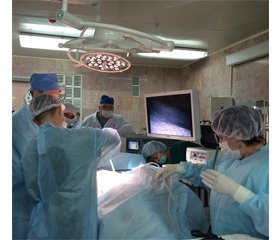Журнал «Медицина неотложных состояний» 7 (62) 2014
Вернуться к номеру
Prevention of Postural Hemodynamic Changes During Percutaneous Nephrolithotripsy in Different Schemes of General Anesthesia
Авторы: Rud O.A., Naumenko O.V. — State Scientific Institution «Scientific and Practical Center of Preventive and Clinical Medicine» of Dnipropetrovsk Regional Council, Dnipropetrovsk, Ukraine
Рубрики: Медицина неотложных состояний
Разделы: Справочник специалиста
Версия для печати
Summary. In our study, we compared the expression of translational changes of hemodynamics during surgery on kidney stones, including staghorn stonesin various schemes of general anesthesia (total intravenous anesthesia propofol and sevoflurane inhalation anesthesia).
In modern medicine is increasingly spreading receiving minimally invasive surgery techniques, which include percutaneous nephrolitotrypsia (PCNL). The longest stage of this operation is in the patient's belly. Accesstothe renal collecting system, and often stage of crushing and removing pieces of stones kidney behaves in the patient's stomach for roller derived from epigastric to facilitate the work of the surgeon. In this position, the compression is lower of cava inferior vein, causing decreased venous return to the heart (preload reduction). However, as a result of an increase in intra-abdominal and intrathoracic pressure increases total peripheral vascular resistance (afterload increase) and reduced left ventricular сompline. With mechanisms reduce cardiac output. But the increase in total peripheral vascular resistance maintains mean blood pressure at a level sufficient for adequate perfusion of tissues and organs.
Purpose — to determine whether the choice of anesthetic for general anesthesia clinically significant effects on hemodynamic profile of the patient while performing PCNL.
For the study were selected 60 patients aged 18 to 64 years with physiological status I–II classification of the American Society of Anesthesiologists (ASA), which was planned PCNL under general anesthesia, and subsequently operated routinely one surgical-anesthesia care team.
Non-inclusion criteria were patient refusal to participate in the study; BMI less than 18.5 and more than 34.9 kg/m2; presence of decompensated chronic and acute respiratory diseases, cardiovascular system, liver, kidneys and endocrine system; alcoholism and drug addiction; use of psychotropic drugs and β-blockers; presence of heart defects fixed cardiac output (aortic stenosis hole); pregnancy.
Exclusion criteria — surgical complications during surgery and in the postoperative period.
The study evaluated and compared the blood pressure at different stages of surgery in both groups of patients. To exclude the impact of inadequate depth of anesthesia on hemodynamic profile used bispectrum monitoring index (BIS). In step support anesthesia dose drugs — propofol and sevoflurane — dosed on indicators of BIS and held 40–60 units according to the manufacturer's monitor.
The study found that, subject to the optimum depth of anesthesia (bispectrum index 40–60 units) during PCNL hemodynamic profile of the patient does not depend on the choice of anesthetic to maintain general anesthesia. To reduce the negative impact of translational hemodynamic changes we recommend if possible to reduce the duration of stage operations derived roller operating table in the epigastric region.

